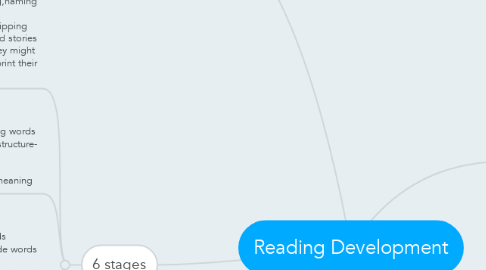Reading Development
by Abby Nosoff

1. 6 stages
1.1. Pre Reading (Birth-Kindergarten) Parents "read" to the kids by pointing,naming objects and color Simple Stories - 3 year olds pretend flipping through books and reciting memorized stories and create their own. Kindergarten they might know their ABC's written letters, and print their own name
1.2. 2nd- 3rd grade Develop Fluency Skills -more fluent recognizing and decoding words -Rereading and reading with familiar structure- they are gaining speed, fluency, and confidence. "Learning to Read" and focuses on meaning
1.3. 1st-2nd grade Reading and decoding at this point -Letters with their corresponding sounds Using phonics to sound out and decode words by sound run together Whole words method - recognize words based on context, picture, and shape of word -focus on word and phrase, but misses the meaning of the story
1.4. 4th Grade - Printed materials to study subjects
1.5. HS Develop multiple view points derived from many facts Appreciate layers of information with different view points and theory. More mature fiction and nonfiction are given.
1.6. Mature (College and Adult) -Multiple sources, opinions, views, and then can construct their own understanding -Read to suit their purpose - gain understanding, entertainment, view of others -Can read fast, deep, gloss, skim, or attend to detail based on what they need. -Know what not or what to do
2. Difficulities
2.1. Can't blend printed letters together to form words Phonemic awareness isn't there
3. Success
3.1. -Familiarity with letters -Phonemic awareness- once developed they can pick up speed -Strong readers quickly learn to recognize words -Strong decoding and phonemic are better to sound out words is easier to read -Easier it is to read - they will read more
4. Advice
4.1. Getting read to aloud by parents at a young age has weak evidence to show it helps -It has a small direct effect on the child -Once children reading -the amount of of time reading is a strong predictor of later strengths in reading, language ability, vocab, writing, story telling, rich of ideas, content area achievement and overall knowledge so get students to read often, as broadly and thoughtfully as often as you can.
5. 25% of people in America are poor readers and 38% of 4th graders are below average.


